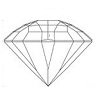16.04: Beryl
- Page ID
- 3273
| Beryl | |
|---|---|
| Chemical composition | Be3Al2(SiO3)6Beryllium aluminum silicate |
| Crystal system | Hexagonal |
| Habit | Prismatic |
| Cleavage | Very difficult in one direction, rarely seen |
| Fracture | Conchoidal |
| Hardness | 7.25-7.75 |
| Optic nature | Uniaxial - |
| Refractive index | 1.577-1.583 (+ or - 0.017) |
| Birefringence | 0.005-0.009 |
| Dispersion | Low, 0.014 |
| Specific gravity | 2.72 (+0.18,- 0.05) |
| Lustre | Vitreous to resinous |
| Pleochroism | Weak to moderate |
Beryl is a beryllium aluminum silicate that occurs in every color of the rainbow. When green, it's usually called emerald but there exists green beryl, which is not entitled to be called emerald because its coloring agent is different. When blue, it's aquamarine and when pink, morganite. Yellow is heliodor and colorless is goshenite.
A rare raspberry red variety found in Utah is called bixbite. There is a very rare and costly variety termed Riesling beryl, that can be described as pale green colored with a warm, golden yellow flash. Two unusually dark blue types of beryl have been found as well: Maxixe beryl and True Blue Beryl. Maxixe beryl fades with exposure to light, True Blue Beryl does not.
Beryl has been used as a physician's tool and for gazing stones since ancient times. Those beliefs persist today. Beryl is metaphysically attributed with the ability to cure a number of intestinal and stomach ills, such as nausea, ulcers, and seasickness.
Characteristics
The optical and physical data of beryl can vary between varieties and localities.
Beryl belongs to the beryl group. Pezzottaite (IMA approved in 2003) is also a member of the beryl group.
Genesis
Metamorphic rocks in pegmatites
Localities
Beryl is found in many localities, among them being Brazil, India, Africa, Columbia, Australia, and Pakistan.
Habit
Prismatic with pyramidal and/or pinacoidal terminations. Often vertically striated.
Physical data
Mohs hardness: 7.25 - 7.75 (emerald is brittle).
Specific gravity: 2.7 to 2.9, depending on variety.
Optical data
Refractive index: nε = 1.56 nω = 1.59, depending on variety.
Birefringence: 0.004 to 0.009, depending on variety.
Optical sign: uniaxial negative.
Dispersion: low, 0.014.
Pleochroism: weak to moderate, strong in "True Blue Beryl" and pezzottaite.
Diaphaneity
Transparent to opaque.
Colors
All varieties of beryl are allochromatic. Main coloring agents are given below.
- Green (emerald), colored by chromium 3+
- Green (vanadium beryl), colored by vanadium 3+ - Also known as vanadium emerald
- Green (green beryl), colored by ferric 3+ and ferrous 2+ iron
- Green/Yellow (Reisling beryl), unknown coloring agent (most likely iron)
- Blue (aquamarine), colored by ferrous 2+ Iron
- Blue (Maxixe), colored by color centers
- Blue (True Blue), colored by ferrous 2+ iron - Trade name for high FeO content aquamarine
- Pink (morganite), colored by manganese 2+
- Red (bixbite), colored by manganese 3+
- Yellow (heliodor), colored by ferric 3+ Iron
- Colorless (goshenite)


